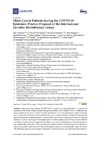Identificador persistente para citar o vincular este elemento:
https://accedacris.ulpgc.es/jspui/handle/10553/73060
| Campo DC | Valor | idioma |
|---|---|---|
| dc.contributor.author | Nguyen, Nam P. | en_US |
| dc.contributor.author | Vinh-Hung, Vincent | en_US |
| dc.contributor.author | Baumert, Brigitta | en_US |
| dc.contributor.author | Zamagni, Alice | en_US |
| dc.contributor.author | Arenas, Meritxell | en_US |
| dc.contributor.author | Motta, Micaela | en_US |
| dc.contributor.author | Lara, Pedro Carlos | en_US |
| dc.contributor.author | Myint, Arthur Sun | en_US |
| dc.contributor.author | Bonet, Marta | en_US |
| dc.contributor.author | Popescu, Tiberiu | en_US |
| dc.contributor.author | Vuong, Te | en_US |
| dc.contributor.author | Appalanaido, Gokula Kumar | en_US |
| dc.contributor.author | Trigo, Lurdes | en_US |
| dc.contributor.author | Karlsson, Ulf | en_US |
| dc.contributor.author | Thariat, Juliette | en_US |
| dc.date.accessioned | 2020-06-08T09:18:57Z | - |
| dc.date.available | 2020-06-08T09:18:57Z | - |
| dc.date.issued | 2020 | en_US |
| dc.identifier.issn | 2072-6694 | en_US |
| dc.identifier.other | Scopus | - |
| dc.identifier.uri | https://accedacris.ulpgc.es/handle/10553/73060 | - |
| dc.description.abstract | The coronavirus disease 19 (COVID-19) pandemic is unprecedented as it reached all countries in the world within a record short period of time. Even though COVID-19 infection may be just severe in any adults, older adults (65-year-old or older) may experience a higher mortality rate. Among those affected, cancer patients may have a worse outcome compared to the general population because of their depressed immune status. As the health resources of most countries are limited, clinicians may face painful decisions about which patients to save if they require artificial ventilation. Cancer patients, especially the older ones, may be denied supportive care because of their shorter life expectancy. Thus, special considerations should be taken to prevent infection of older cancer patients and to provide them with adequate social support during their cancer treatment. The following proposal was reached: (1) Education of health care providers about the special needs of older cancer patients and their risks of infection. (2) Special consideration such as surgical masks and separate scheduling should be made to protect them from being infected. (3) Social services such as patient navigators should be provided to ensure adequate medical supply, food, and daily transportation to cancer centers. (4) Close monitoring through phone calls, telecommunication to ensure social distancing and psychological support from patient family to prevent anxiety and depression. (5) Shorter course of radiotherapy by use of hypofractionation where possible to decrease the needs for daily transportation and exposure to infection. (6) Enrollment of older cancer patients in clinical trials for potential antiviral medications if infection does occur. (7) Home health care telemedicine may be an effective strategy for older cancer patients with COVID-19 infection to avoid hospital admission when health care resources become restricted. (8) For selected patients, immunotherapy and targeted therapy may become the systemic therapy of choice for older cancer patients and need to be tested in clinical trials. | en_US |
| dc.language | eng | en_US |
| dc.relation.ispartof | Cancers | en_US |
| dc.source | Cancers [EISSN 2072-6694], v. 12 (5), (Mayo 2020) | en_US |
| dc.subject | 3202 Epidemologia | en_US |
| dc.subject | 320101 Oncología | en_US |
| dc.subject.other | Cancer Patients | en_US |
| dc.subject.other | Corona Virus 19 | en_US |
| dc.subject.other | Epidemic | en_US |
| dc.subject.other | Older | en_US |
| dc.subject.other | Treatment | en_US |
| dc.title | Older cancer patients during the COVID-19 epidemic: Practice proposal of the international geriatric radiotherapy group | en_US |
| dc.type | info:eu-repo/semantics/Article | en_US |
| dc.type | Article | en_US |
| dc.identifier.doi | 10.3390/cancers12051287 | en_US |
| dc.identifier.scopus | 85085359522 | - |
| dc.contributor.authorscopusid | 7403180242 | - |
| dc.contributor.authorscopusid | 6701423248 | - |
| dc.contributor.authorscopusid | 7003918100 | - |
| dc.contributor.authorscopusid | 57204187580 | - |
| dc.contributor.authorscopusid | 14420842300 | - |
| dc.contributor.authorscopusid | 23973573300 | - |
| dc.contributor.authorscopusid | 7004374085 | - |
| dc.contributor.authorscopusid | 56246027300 | - |
| dc.contributor.authorscopusid | 14053541900 | - |
| dc.contributor.authorscopusid | 56199206300 | - |
| dc.contributor.authorscopusid | 57202702363 | - |
| dc.contributor.authorscopusid | 57194697121 | - |
| dc.contributor.authorscopusid | 36476713200 | - |
| dc.contributor.authorscopusid | 7004688413 | - |
| dc.contributor.authorscopusid | 16240019100 | - |
| dc.identifier.eissn | 2072-6694 | - |
| dc.identifier.issue | 5 | - |
| dc.relation.volume | 12 | en_US |
| dc.investigacion | Ciencias de la Salud | en_US |
| dc.type2 | Artículo | en_US |
| dc.description.numberofpages | 10 | en_US |
| dc.utils.revision | Sí | en_US |
| dc.date.coverdate | Mayo 2020 | en_US |
| dc.identifier.ulpgc | Sí | es |
| dc.description.sjr | 3,052 | |
| dc.description.jcr | 6,86 | |
| dc.description.sjrq | Q1 | |
| dc.description.jcrq | Q1 | |
| dc.description.scie | SCIE | |
| item.grantfulltext | open | - |
| item.fulltext | Con texto completo | - |
| Colección: | Artículos | |
Citas SCOPUSTM
30
actualizado el 08-jun-2025
Citas de WEB OF SCIENCETM
Citations
28
actualizado el 08-jun-2025
Visitas
158
actualizado el 12-jul-2025
Descargas
153
actualizado el 12-jul-2025
Google ScholarTM
Verifica
Altmetric
Comparte
Exporta metadatos
Los elementos en ULPGC accedaCRIS están protegidos por derechos de autor con todos los derechos reservados, a menos que se indique lo contrario.
